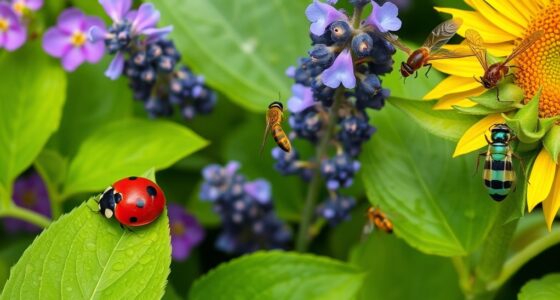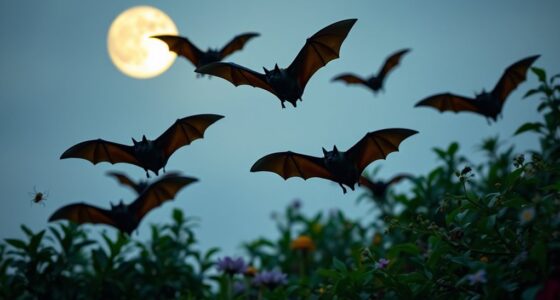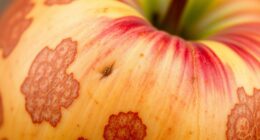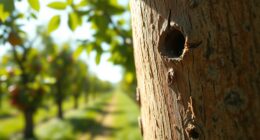To support your garden’s health, you should know about ladybugs, parasitic wasps, pollinators like bees, hoverflies, lacewings, beetles, and assassin bugs. Ladybugs and hoverfly larvae naturally control pests like aphids, while parasitic wasps target specific invaders. Pollinators boost fruit and flower production, and beetles and assassin bugs help manage other pests. Learning about these beneficial insects will help you create a thriving, eco-friendly garden that needs fewer chemicals. Keep exploring to discover how each one can work for you.
Key Takeaways
- Ladybugs effectively control aphids, scale insects, and mealybugs, reducing the need for chemical pesticides.
- Parasitic wasps target pests like caterpillars and whiteflies by laying eggs inside them, promoting natural pest control.
- Pollinators such as bees and native bees are crucial for fruit and flower pollination, enhancing garden productivity.
- Hoverflies larvae prey on aphids and thrips, providing early-season pest management while adults pollinate plants.
- Encouraging diverse flowering plants and habitat features supports a healthy population of beneficial insects.

Beneficial insects play a crucial role in maintaining a healthy garden by naturally controlling pests and promoting plant growth. When you incorporate these insects into your gardening routine, you create a sustainable system that reduces the need for chemical pesticides and supports ecological balance. Understanding which beneficial insects to encourage can considerably improve your pest control strategies and enhance pollination, leading to more fruitful and vibrant plants.
Encouraging beneficial insects supports natural pest control and healthy plant growth while reducing chemical use in your garden.
Ladybugs are among the most popular beneficial insects because they feast on common garden pests like aphids, scale insects, and mealybugs. By attracting ladybugs to your garden, you harness their natural predation to keep pest populations in check. You can do this by planting nectar-rich flowers, such as dill or fennel, which provide food sources for adult ladybugs. This approach not only helps control pests but also reduces the need for chemical interventions, which can harm beneficial insects and disrupt pollination processes.
Another key beneficial insect is the parasitic wasp. These tiny wasps are highly effective at targeting specific pests, such as caterpillars or whiteflies, by laying their eggs inside the pest insects. As the wasp larvae develop, they consume their hosts from within, drastically reducing pest numbers. To attract parasitic wasps, you should plant a variety of flowering plants that bloom throughout the growing season, offering continuous nectar and pollen sources. This strategy supports a diverse ecosystem that naturally manages pest populations while promoting pollination enhancement, ensuring your plants are both protected and productive.
Pollinators like bees also play an essential role in a thriving garden. While honeybees are well known, native bees such as solitary bees and bumblebees are equally important. These insects are responsible for pollinating a broad range of plants, including fruits, vegetables, and flowers. To encourage their presence, you should provide habitat features like bee hotels or undisturbed ground patches. Avoiding pesticides and planting a variety of native flowering plants can create a welcoming environment that boosts pollination success and improves overall garden health.
Hoverflies are another beneficial insect that you might overlook. Their larvae are voracious predators of aphids and thrips, while the adults feed on nectar and pollen. Hoverflies are particularly useful during the early growing season when pest pressure is high. By planting a diverse array of flowers, especially those with open, flat blooms, you’ll attract hoverflies and bolster your pest control strategies. Their presence not only helps manage pests but also contributes to pollination, supporting the overall vitality of your garden.
Additionally, understanding the Refrigeration Cycle can help gardeners better comprehend how to preserve harvested fruits and vegetables, ensuring their freshness and longevity. Incorporating these beneficial insects into your gardening practices creates a natural, effective system that reduces reliance on chemicals, enhances pest control strategies, and promotes pollination enhancement. By understanding their roles and creating inviting habitats, you set your garden on the path to sustainability, productivity, and ecological harmony.
Frequently Asked Questions
How Can I Attract Beneficial Insects Naturally?
To attract beneficial insects naturally, focus on using natural attractants like native plants that provide nectar and pollen. Create habitat by leaving some areas undisturbed with leaf litter or small piles of wood, which serve as shelter. Avoid pesticides, and plant diverse flowers to support different beneficial species throughout the season. These strategies encourage beneficial insects to stay, helping your garden thrive without chemical interventions.
Are There Any Risks in Introducing Beneficial Insects?
Hold your horses, cobber! While biological pest control with beneficial insects is a great way to naturally protect your garden, there are some risks. Introducing insects without proper insect habitat enhancement can disrupt the ecosystem or lead to unintended consequences. Make sure you research and choose the right beneficial insects for your garden, and always monitor their impact to prevent any imbalance or pest outbreaks. Safety first, mate!
How Do I Identify Different Beneficial Insect Species?
To identify different beneficial insect species, start by observing their size, color, and shape, which can vary widely. Pay attention to their behaviors and the plants they frequent, as many thrive in specific beneficial insect habitats. Learning plant pest identification helps you distinguish pests from beneficial insects. You can also consult field guides or online resources, and consider joining local gardening groups for advice on recognizing these helpful insects.
What Is the Lifespan of Common Beneficial Insects?
Imagine a fleeting butterfly’s life against the steady presence of a hardworking ladybug. The lifespan of common beneficial insects varies; for instance, ladybugs live around a year, while parasitic wasps may only last a few weeks. In pest management, understanding these durations helps you maintain effective insect habitats, ensuring continuous natural pest control. Knowing their lifespans lets you plan for ongoing support, keeping your garden balanced and healthy.
Can Beneficial Insects Control All Garden Pests Effectively?
You might wonder if beneficial insects can control all garden pests effectively. While they’re great at reducing pest populations, they can’t eliminate every pest due to pest resistance or if you rely solely on chemical dependency. Beneficial insects work best as part of an integrated pest management plan, minimizing the need for chemicals and helping prevent pests from developing resistance. This balanced approach boosts garden health naturally and sustainably.
Conclusion
By welcoming these beneficial insects into your garden, you’re planting a symphony of natural harmony. Think of them as your garden’s tiny orchestra, each playing their part to keep pests at bay and your plants thriving. Embrace their presence, and you’ll cultivate a balanced, vibrant oasis that blooms with health and vitality. With these helpful allies, your garden becomes a thriving masterpiece, where nature’s rhythm sustains itself in perfect harmony.









